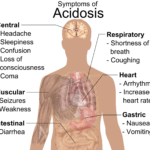- Patient presentation
- History
- Differential Diagnosis
- Examination
- Investigations
- Discussion
- Treatment
- Final outcome
- References
- Evaluation – Questions & answers
Patient presentation
A 25 year old female presents to her primary healthcare clinic complaining of flu-like symptoms which consist of a fever, headache, myalgia, abdominal pain, nausea and fatigue.
Acknowledgement
This case study was kindly provided by Dr Monica Mercer from Immunopaedia
History
Ms L is a 25 year old female who lives in an informal settlement in Johannesburg. She shares a 2 roomed house with two adult cousins and her boyfriend. They have electricity and running water. She is employed part time as a domestic worker and is often the only breadwinner for the household.
8 months ago
She was admitted to hospital for cryptococcal meningitis for which she was successfully treated. At this time she was diagnosed as HIV infected with a CD4 count of 115 and a viral load (VL) of 25000 copies. She was started on an antiretroviral regimen which consists of lamivudine (3TC), stavudine (d4T) and efavirenz (EFV).
2 months ago
She was responding well to therapy and her CD4 count increased to 450 and her viral load was undetectable at <25 copies.
1 week ago
She came to the clinic complaining of weakness, myalgia, headache, nausea and general flu-like symptoms. She also complained of a non-tender lump on her left thigh. She was prescribed acetaminophen and told to return in one week if her symptoms did not improve.
Differential Diagnosis
- Influenza
- Cryptococcus meningitis
- IRIS- unlikely because she has been on treatment for 8 months
- Defaulting on treatment
- Drug toxicity
Examination
Vitals:
BP: 105/55
Temp: 37.5˚C
Respiratory rate: 24
Pulse: 100
Abdominal Examination:
Right upper abdomen is very tender on palpation.
Hepatomegaly is noted
Lower Limb Examination:
Small, soft, mobile, non- tender tumor found on medial aspect of left thigh. This has been identified as a lipoma.
The remainder of the examination is nil of note
Investigations
| Leukocyte Esterase | Trace |
|---|---|
| Glucose | Negative |
| Protein | Negative |
| Ketones | Trace |
| Blood | Negative |
| Na | 138 | (135-147 mmol/l) |
|---|---|---|
| K | 4 | (3.3-5.0 mmol/l) |
| CI | 100 | (99-103 umol/l) |
| HC03 | 14 | (18-29 mmol/l) |
| Urea | 7.2 | (2.5-6.4 mmol/l) |
| Creatinine | 170 | (62-115 mmol/l) |
| Anion Gap | 28 | (10-18 mmol/l) |
| Total Bilirubin | 3 | (3-18 umol/l) |
|---|---|---|
| Direct Bilirubin | 1.7 | (0-5 umol/l) |
| ALP | 52 | (30-120 U/L) |
| GGT | 15 | (5-35 U/L) |
| ALT | 90 | (5-45 U/L) |
| AST | 85 | (5-45 U/L) |
| Lactate | 8 | (<1.5 mmol/l) |
| Ultrasound of her abdomen | Confirmed the hepatomegaly and showed fatty infiltration. |
Discussion
From our results we see this patient has a metabolic acidosis. The diagnosis of metabolic acidosis is based on a calculation which estimates the unmeasured anions and is called the anion gap. The formula used is (Na + K) – (Cl – HCO3).
In this case we have a raised anion gap which indicates the patient has a metabolic acidosis.
Causes of metabolic acidosis
This occurs due to an increase in production of organic acids, resulting in a fall in HCO3 or other unmeasured anions and is thus associated with the accumulation of acids.
Causes include:
- Lactic acidosis caused by sepsis, shock or hypoxia
- Urate caused by renal failure
- Ketones caused by diabetes mellitus, alcohol or starvation
- Drugs (salicylates, biguanides, ethylene, NRTIs)
Treatment
- Patient was admitted to hospital
- All HIV medication was stopped
- L-carnitine 50mg/kg was given per day
- Blood lactate levels measured daily
Final outcome
After 20 days her blood results were within normal ranges.
Her CD4 count has however dropped down to 250 and her viral load has increased to 10000 copies. Her declining CD4 count requires that she be carefully monitored and as soon as she reaches 200 she must go back onto ARV therapy. Which will again consist of two NRTIs and an NNRTI, but she will be given two different NRTIs. Fortunately toxicity does not extend to all the drugs in this class.
| Values | Normal Limits | |
|---|---|---|
| Urea Creatinine and Electrolytes | ||
| Na | 136 | 135 – 147 mmol/l |
| K: | 4 | 3.3 – 5.0 mmol/l |
| CI: | 103 | 99 – 103 µmol/l |
| HCO3: | 21 | 19 – 29 mmol/l |
| Urea: | 6 | 2.5 – 6.4 mmol/l |
| Creatinine: | 110 | 62 – 115 mmol/l |
| Anion Gap | 16 | 10 – 18 mmol/l |
| Lactate | 1 | <1.5 mmol/l |
References
Yann-Erick Claessens et al. (2003) Bench-to-bedside review: Severe lactic acidosis in HIV patients treated with nucleoside analogue reverse transcriptase inhibitors.
Crit Care. 2003; 7(3): 226–232. Fz
Fauci and Lane. (2005) Chapter in Harrison’s Principles of Internal Medicine,
Volume 1. 16th edition. Section 14: 1125-1137.
Additional discussion points have been adapted from a similar case located in The Body
Evaluation – Questions & answers
What is the diagnosis?
How does lactic acidosis occur?
What are the signs and symptoms of mitochondrial toxicity which occur with NRTIs?
Hepatic or gastrointestinal- steatosis, lactic acidosis, pancreatitis
Neuromuscular – myopathy or polyneurophathy
Haematologic – pancytopenias
Nephrologic – proximal renal tubular dysfunction
What are the clinical features of NRTI toxicity?
- Nausea and vomiting
- Abdominal pain
- Hepatomegaly
- Tachypnoea
- Asthenia
- Metabolic acidosis
- Lactic acidosis
How does hepatic steatosis occur?
What are the risks of prolonged lactic acidosis?
What is the importance of performing blood lactate levels?
